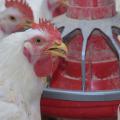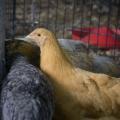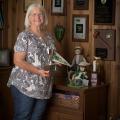Pesticides
External parasites on poultry are a common problem in small flocks of birds. They often come in contact with the parasites or their eggs while foraging for food. The problems are less frequently encountered in commercial poultry flocks but treatments may also need implementing in these flocks. Several pesticides provide excellent protection against parasites. The product used and the method of administration is dependent on the parasite and type of housing conditions being used. A description of the most commonly encountered parasites can be found in the parasite section of Diseases of Poultry.
Listed below are several chemicals that have been approved for treating various poultry pests. Regardless of the chemical used in the poultry house, follow all precautions listed on the label to prevent the possibility of health risks to the poultry or humans.
Permethrin
5.7% EC Spray -- Dilute 7 tsp/gal or 1 qt/25 gal for .05% solution
-- Dilute 4 1/2 Tbs per gallon for .1% solution
10% EC Spray -- Dilute 4 tsp/gal or 1 qt/50 gal for .05% solution
-- Dilute 2.5 Tbs/gal or 1 qt/25 gal for .1% solution
11% EC Spray -- Dilute 3.5 tsp/gal or 1 pt/25 gal for .05% solution
-- Dilute 7 tsp/gal or 1 qt/25 gal for .1% solution
25% WP -- 1.5 tsp/gal or 1 pt/30 gal for .05% solution
-- 1 Tbs/gal or 1 pt/15 gal for .1% solution
The .1% solution is applied to ceilings, walls, and suspended objects using a pressurized or power sprayer. This residual spray may remain effective for several weeks unless removed by washing or rain.
The .05% solution can be applied directly to the birds at the rate of 1 gallon per 75 adult chickens. The solution applied to the birds is effective for mites only. Pay particular attention to the vent area when spraying to insure complete spray penetration and coverage.
.25% Dust -- Apply with shaker can at rate of 1 lb/100 birds. Dust to cover vent area. Recommended for treatment of mites only.
Carbaryl (Sevin)
50% WP -- Dilute 7 oz/5 gal for .5% solution.
80% WP -- Dilute 4 oz/5 gal for .5% solution.
43% EC Spray -- Dilute 7 oz/5 gal for .5% solution.
Apply to birds with a pressurized or power sprayer at the rate of 1 gallon per 75 adult hens. Carbaryl is a restricted chemical. Users must obtain a permit from the Agricultural Commissioner.
Spray the vent and fluff areas from beneath the bird. Provide mechanical agitation or stir mixture frequently. For litter operations, an evenly sprayed application can be made to the litter surface. Avoid contamination of feed and water. Treatment of infested birds only may be preferable to treating all birds in a flock. Northern Fowl Mites are tolerant to carbaryl in some poultry production areas.
Do not repeat treatment more often than every four weeks. Do not apply within seven days of slaughter.
5% Dust -- Apply with shaker can at rate of 1 lb/100 birds or dust bath box at rate of 5 lb/100 birds.
10% Dust -- Apply with shaker can at rate of .5 lb/100 birds or dust bath box at rate of 2.5 lb/100 birds. When using a dust box, the size should be 24"x36"x4".
Rabon
50% WP -- Dilute 2 lb/25 gal for .5% solution.
Spray vent and fluff areas from beneath the bird. Do not repeat more than once every 14 days. For individual bird treatment, apply 1 oz of .5% solution on each bird. For litter operations, apply spray evenly to litter surface. Northern Fowl Mite is tolerant to Rabon in some areas.
3% Dust Powder -- Dust bath box; 5 lb/100 birds.
Individual birds can be treated with a shaker can or hand duster by applying .5 oz/bird.
Ravap
23% Rabon -- Dilute .5 gal/25 gal or 5 oz/gal
5.3% Vapona for .6% solution
EC Spray
Apply to birds with a pressurized or power sprayer at the rate of 1 gallon per 75 adult hens.
Publications
News
STARKVILLE, Miss. -- Until an avian flu vaccine for chickens or other alternative is federally approved, commercial poultry operations in the U.S.
STARKVILLE, Miss. -- If egg prices have seemed higher than ever lately, it’s because they are, and consumers can place much of the blame squarely at the feet of the ongoing bird flu outbreak.
With highly pathogenic avian influenza, or HPAI, in the environment in Mississippi, owners of backyard flocks have to take extra steps to keep their chickens healthy.
Avian influenza poses an extremely low risk to human health and none to food safety in Mississippi, but its presence poses a risk to backyard flocks and the state’s $3 billion commercial poultry industry.
Success Stories
In late February, Mississippi State University hosted the 2024 National Floriculture Forum, an annual conference held at different locations around the country.
Children who enjoy hands-on learning and want to showcase their accomplishments and compete against fellow participants can join the 4-H Poultry Chain Project.
She grew up in the 4-H youth development program in Indiana, and her husband was in Ohio 4-H. Fast-forward a few years, and Inez Saum became a volunteer leader for Mississippi 4-H.










